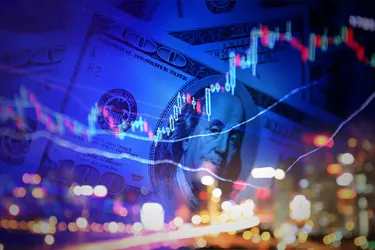Consumer spending for goods and services represents about two-thirds of the U.S. economy, making it the primary force driving economic growth. Personal consumption expenditures (PCE) is the metric used to measure the amount and price changes in consumer spending. An increase in the PCE means that households are paying more for the same amount of goods and services; in other words, inflation has driven up the costs of living.
The core PCE price index is the metric preferred by the Federal Reserve Bank to measure inflation rather than the more well-known consumer price index (CPI). Here's what the PCE measures.
Video of the Day
Video of the Day
Personal Consumption Expenditures Price Index Basics
The Bureau of Economic Analysis (BEA) defines the "core" PCE as personal spending by consumers for goods and services, excluding food and energy prices because they are more volatile. The purpose of the index is to identify the core PCE inflation trends and measure the changes in households' cost of living.
The BEA follows prices in a basket of goods and services with items weighted according to how much a household spends. The BEA regularly changes its basket of goods and services to account for consumers substituting one cheaper item for another as prices rise and changes in consumer preferences, such as lifestyle changes brought on by the pandemic.
Consider also: Why You Need to Care About Shadow Inflation
How Is the PCE Calculated?
The BEA calculates the PCE index each month based on data collected from surveys of businesses and publishes the results in a report known as "Personal Income and Outlays." Its sources include:
- Government regulatory and administrative agency reports
- Statistical reports produced by the U.S. Census Bureau
- Reports from trade associations and other private organizations
Personal consumption expenditures classifications include:
- Durable goods: These are items that will last three or more years, such as cars and trucks, household appliances and recreational vehicles.
- Nondurable goods: These items will be consumed and last less than three years, like gasoline, clothing and food and beverages.
- Services: Services include things such as housing, recreational activities, eating out at restaurants, hotel accommodations and insurance.
The BEA calculates the inflation rate by adding up the total amount of money spent in its basket of goods and services and compares this figure to the previous month's total. These prices are adjusted to current dollar values for seasonal variations.
The BEA normalizes these prices with a price deflator, which is a ratio of the amount of all goods and services produced in the year at current prices to the prices that existed in the selected base year. This ratio becomes the monthly PCE index or rate of inflation.
Federal Reserve Uses Core PCE
The policymakers and economists at the Fed use the core PCE to guide the central bank's strategy when making monetary policy decisions.
For example, the Fed has a long-term benchmark to stabilize inflation at an annual rate of 2 percent. To achieve this goal, they will use the inflation rate calculated from the core PCE to make adjustments in the money supply and control interest rates.
Consider also: How Does Inflation Affect the Value of Money?
Difference Between PCE and CPI
Both PCE and CPI record consumer spending and measure inflation, but they use different data sources.
The CPI uses household surveys collected by the Bureau of Labor Statistics rather than reported sales figures from businesses. These surveys cover several thousand families and contain price data on about 80,000 consumer items.
The PCE index uses data from the gross domestic product report and business organizations. Unlike the CPI, the PCE index includes costs paid by others for the benefit of consumers, such as employer-covered medical costs. As a result, the PCE index is less volatile, more inclusive and is a more accurate inflation gauge than the CPI.
- Bureau of Economic Analysis: Personal Consumption Expenditures Price Index
- Forbes: PCE Inflation: The Personal Consumption Expenditures Price Index
- Federal Reserve System: What Economic Goals Does the Federal Reserve Seek to Achieve Through its Monetary Policy?
- Bureau of Economic Analysis: Personal Consumption Expenditures
